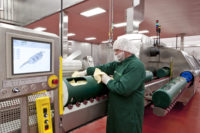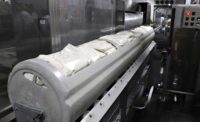Typically, when a food manufacturer wants to extend the shelf life of a particular product, they’ll add a freezing component. Once frozen, the product is good to go for some time. But, what if freezing isn’t an option? Such is the case for refrigerated foods.
Today’s high-pressure processing (HPP) systems add the extended shelf life component for refrigerated foods without having to incorporate a freezing method.
Why use HPP?
HPP is a pasteurization method for the inactivation of microorganisms, particularly vegetative foodborne pathogens and shelf-life organisms such as spoilage bacteria, according to Errol Raghubeer, vice president, microbiology and food technology for Avure Technologies, Franklin, Tenn.
“Basically, it is the compression of a liquid, which in this case is water. It is done in a pressure chamber where foods are subjected to pressures as high as 6,000 bars for a short duration. Products are packaged in a hermetically-sealed container, whether it’s a plastic bottle or a tray with film on top or a plastic bag,” he adds. “During that compression of liquid, physical, biochemical and chemical changes occur, which affect living systems, such as microorganisms, with basically insignificant effect on the food itself other than some positive effects on carbohydrates and proteins. Nutrients and other bioactive compounds are largely unaffected.”
In other words, HPP is “a reverse submarine that takes packaged food products to a water pressure five times greater than the deepest part of the ocean, holds for a period of time, then releases,” says Eric Lockovitch, vice president of global business development for All Natural Freshness, Inc., White Pigeon, Mich. “The extreme pressure inactivates all the bad pathogens in our food and maintains all the good vitamins and nutrients. No heat is used, which is what typically destroys the good stuff in our food when pasteurizing.”
Refrigerated food manufacturers focus on incorporating HPP systems in their production lines for a variety of reasons—to remove preservatives and extend shelf life of most ready-to-eat (RTE) items such as deli meat, gourmet sausages, hot dogs, pulled rotisserie chicken, smoked barbeque items like brisket and pulled pork, fresh-cut fruits and vegetables, sauces, soups, dips, meal trays and kits, wet salads, pasta or rice entrées and fresh-squeezed juices. However, food safety remains the No. 1 reason why HPP is considered and utilized.
“[HPP] gives us the opportunity to have natural foods in the marketplace,” Raghubeer says. “You can reduce or eliminate chemicals and preservatives, and in some ways indirectly reduce the amount of sodium you have. It is also a technology that is highly regarded with regulatory agencies such as the FDA and USDA because you have safer food for the consumers.”
To better enforce food safety, West Liberty Foods, West Liberty, Iowa, installed an HPP system from Hiperbaric USA Corp., Miami. The Hiperbaric 420 is said to be the next generation of industrial HPP equipment, featuring a 420-liter capacity and 380 mm diameter vessel with eight high-pressure intensifiers, processing up to 6,000 pounds of product per hour.
“Our HPP technology is suitable for refrigerated RTE meals in flexible sealed packaging such as trays, bottles, pouches or bags,” says Jaime Nicolás-Correa, global commercial manager for Hiperbaric. “HPP can provide multiplied shelf life and increased food safety in product references that, due to their ingredient mix, can be tricky in terms of microbial spoilage and cross contaminations as well as eventual presence of pathogenic organisms.”
If processors are looking for ways to eliminate the threat of product recalls due to contamination concerns, HPP systems offer a strong food safety culture, says Guy Giordano, president and CEO of Safe Pac Pasteurization, LLC, Philadelphia, Pa.
“Almost any food product can be HPP processed, as long as the packaging it is in will hold under through the process,” he adds. “The potential is there for almost any food item that is highly perishable or subject to food safety issues to get a level of protection that is not available from other processes.”
Overcoming challenges when choosing HPP
One common challenge refrigerated food processors face when working with HPP systems is the packaging.
“A lot of headspace and gas can slow down the process and break the package in some cases,” says Nicolás-Correa.
HPP can also cause issues like seal failures, says Kelley Battles, founder and CEO of Global Leading Foods, Coppell, Texas.
“As an example, on fresh ground meat or poultry, while MAP packaging [modified atmosphere packaging] might be the preferred method of packaging, other solutions like chubs might perform better under HPP, and therefore give a manufacturer a viable solution,” he says. “Pouched or bag packaging applications that contain gas causes poor load-out volumes in the HPP vessel, which ultimately drives up the cost of HPP. While there can be headspace or gas in packaging, like in fresh-pressed juice bottles, product performs better with minimal headspace or air. Products with air pockets, such as bread, are not a good candidate as they compress and deform under pressure. As well, things like a large Styrofoam cup will shrink down to 1/10th of its original size as a result of HPP.”
Cedarlane Natural Foods, the Carson, Calif., maker of the Frankly Freshline, employs HPP technology to ensure that each item that leaves the factory is safe and of superior quality.
“This technology has been beneficial to the overall way of doing business for Cedarlane,” says Robert Atallah, president and founder. “For example, HPP technology extends Cedarlane’s heritage of fresh, natural, healthy food to a safer, superior quality and longer-lasting platform. Additionally, Cedarlane is the first to introduce HPP entrées to club channels, such as Costco.”
And, because HPP increases the absorption of water by carbohydrates and proteins, it can affect the viscosity of certain products. Therefore, the formulation of some products may need to be adjusted, says Raghubeer.
“That’s a common problem with a lot of carbohydrate-based products [such as hummus],” he adds. “One of the biggest issues is how do we handle products that are processed with air and how do we handle products that are processed with MAP. In 2008, we filed a patent to slow the decompression rates of HPP systems to avoid damages to certain MAP products and packaging.”
Avure is also awaiting a patent to help with the tenderization of meats, and to improve the flavor and tenderness of beef and pork, Raghubeer says.
“Rather than controlling the amount of microorganisms in food products, we’ll be looking at how to have a better quality, better flavor, more tender meat in the marketplace,” he adds.
Another challenge with choosing HPP systems involve the maintenance and cost, Giordano says.
“The large capital investment that is needed is always a consideration,” Giordano says. “Toll processing companies similar to Safe Pac are opening all around the country, and are a perfect solution for companies that can’t afford or don’t want to deal with the maintenance costs and issues that are an integral part of HPP processing.”
All Natural Freshness launched a basket lease program for companies using toll processing facilities to eliminate the inherent double handling costs.
“To date, we offer baskets, automation solutions, validation of HPP recipes and consulting services,” says Lockovitch “We are also finalizing a validation program for HPP toll processors to certify items being processed at the desired pressure and time. We are also in the process of finalizing a new piece of equipment that will completely change the industry concerning up-time, servicing, operational cost and cycle times.”
The future looks… well… safe
The sky is the limit when it comes to HPP solutions, says Lockovitch.
“We are not even approaching the flat portion of the product bell curve yet,” he says.
That’s because consumers are not fully aware of the process and its benefits.
“Currently there are limitations on labeling products with a claim stating that they have been HPP processed,” says Giordano. “There is really no way for a consumer to identify the difference between products that have been HPP processed and those that have not. I am sure once the regulatory issues surrounding the labeling of products that have been HPP processed are resolved, consumers will be demanding the food they eat be HPP processed.”
As a result, retailers are driving the greater presence of HPP items, says Battles.
“The future of HPP is the food industry’s desire for cleaner labels while maximizing product shelf life, and more importantly, product safety,” he says. “HPP has always been well-suited to shelf-life extension and post-lethality treatments for RTE meats and entrées. Another avenue of growth for the use of HPP is expansion into totally different categories outside of meats and poultry. There has been explosive R&D and growth in using HPP on fresh juices. High-pressure processing will see new systems with higher volumes to meet the growing demands of consumers who are beginning to understand the benefits of HPP.”
Overall, HPP technology offers significant value to the refrigerated foods industry, Atallah adds.
“The technology allows national distribution, protection of brand equity and improved margins as a result of reduced shrinkage,” he says.
Whether it’s to extend a product’s shelf life or reduce packaging costs, HPP technology is not only on trend, but also a pertinent solution to today’s food safety fix.
HPP At a Glance
What is high-pressure processing (HPP), and why is it necessary? Here are some fast facts about this up and coming trend for refrigerated foods.
• Began in the early 1800s as a way to rid pathogens in milk.
• State-of-the-art cold pasteurization technology.
• Takes packaged food products to a water pressure five times greater than the deepest part of the ocean.
• Doesn't use heat, which is what typically destroys the vitamins and nutrients in foods when pasteurizing.
• It’s an approved process by the U.S. Food and Drug Administration (FDA) and Department of Agriculture (USDA).
• Designed to remove preservatives, extend shelf life and more importantly, improve food safety. Also allows for the original fresh taste, nutrition and other quality attributes to be retained.
• Applications include most ready-to-eat foods such as deli meat, gourmet sausages, hot dogs, pulled rotisserie chicken, smoked barbeque items like brisket and pulled pork, fresh-cut fruits and vegetables, sauces, soups, dips, meal trays and kits, wet salads, pasta or rice entrées and fresh-squeezed juices.
• Toll processing facilities eliminate the inherent double handling of costs.
• Although HPP is a proven technology, customers and retailers use the HPP process for non-thermal pasteurization, tenderization, marinating and shucking seafood.










